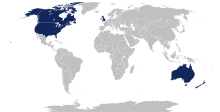Canada–United States relations
 |
|
|
Canada |
United States |
|---|---|
| Diplomatic Mission | |
| Canadian Embassy, Washington, D.C. | United States Embassy, Ottawa |
| Envoy | |
| Ambassador David MacNaughton | Vacant |
| UKUSA Community |
|---|
|
Relations between Canada and the United States of America historically have been extensive, given a shared border and ever-increasing close cultural, economical ties and similarities. The shared historical and cultural heritage has resulted in one of the most stable and mutually beneficial international relationships in the world. For both countries, the level of trade with the other is at the top of the annual combined import-export total. Tourism and migration between the two nations have increased rapport, but border security was heightened after the terrorist attacks in the United States on September 11, 2001. The U.S. is ten times larger in population and has dominant cultural and economic influence. Starting with the American Revolution, when anti-American Loyalists fled to Canada, a vocal element in Canada has warned against US dominance or annexation. The War of 1812 saw invasions across the border. In 1815, the war ended with the border unchanged and demilitarized, as were the Great Lakes. The British ceased aiding First Nation attacks on American territory, and the United States never again attempted to invade Canada. Apart from minor raids, it has remained peaceful.
As Britain decided to disengage, fears of an American takeover played a role in the formation of the Dominion of Canada (1867), and Canada's rejection of free trade (1911). Military collaboration was close during World War II and continued throughout the Cold War, bilaterally through NORAD and multilaterally through NATO. A very high volume of trade and migration continues between the two nations, as well as a heavy overlapping of popular and elite culture, a dynamic which has generated closer ties, especially after the signing of the Canada–United States Free Trade Agreement in 1988.
...
Wikipedia

